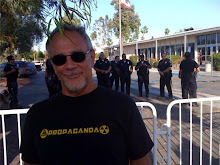 There seems to be a great deal of confusion about what is a collective, what is a cooperative, and what is a dispensary.
There seems to be a great deal of confusion about what is a collective, what is a cooperative, and what is a dispensary.To read some of the many descriptions and definitions of collectives and co-ops you can look on Wikipedia, google, and a variety of mostly excellent medical cannabis websites. Then you’ll be just as confused and befuddled as most people.
The differences are sometimes huge, and sometimes subtle, and it can come down to the feeling one gets becoming a part of a group of individuals working to take care of themselves.
Where there is a necessity, a small group of patients can join together to take care of their needs. This does not mean they have to open a “store” or find other people.
Let’s start with an example of a basic collective:
 Mary has cancer. She cannot tolerate her chemotherapy -- she vomits out her medications and is losing weight.
Mary has cancer. She cannot tolerate her chemotherapy -- she vomits out her medications and is losing weight.Mary is married to Barry. Barry is a stockbroker, and he knows that one of his long-term clients grows marijuana to take care of the symptoms from his AIDS medications. Barry makes a telephone call, and his client, Steve, agrees to meet with Barry and his wife.
But first Barry discusses with Mary his ideas, his fears, and his love. They then discuss medical marijuana with Mary’s doctor, and he agrees that it would be appropriate for Mary to add marijuana to her treatment regimen.
 The couple then visits with Steve. Steve, diagnosed with AIDS in 1998, thought he would die in a few years. He cashed in his life insurance money and bought a nice secluded home that he thought he would retire to and die in peace.
The couple then visits with Steve. Steve, diagnosed with AIDS in 1998, thought he would die in a few years. He cashed in his life insurance money and bought a nice secluded home that he thought he would retire to and die in peace.Wrong! Steve stayed healthy with the new medicines his doctors prescribed, along with the cannabis his doctors agreed he could use to control the nausea and vomiting. After using cannabis for awhile he became fascinated with the plant and the myriad amazing uses that heard that it could be used for. Was it true? Does this little green plant really help millions of people daily around the world fight a variety of ills?
So Steve got a little tiny plant from the local “club,” and he started growing it, and his love grew. Now, a couple years later, Steve has several plants, and is learning that one is best for his appetite, one for his nausea, and one for stress and anxiety relief.
So this evening Barry and Mary visit Steve. They have a lovely evening together, sipping tea and discussing something Mary had never had thought she’d discuss without laughing … MARIJUANA!
 Steve gives Mary a few varieties to try, and plugs in his vaporizer. This is all very confusing to Mary, but after a few tries she starts to get a little less stiff and less uncomfortable inhaling marijuana. It feels weird and strange to her. She had, when younger, tried joints, and cigarettes, but the vaporizer produced … well … almost nothing. It was like she could see nothing but a light mist… it felt cool in her throat…. There is no smell, no taste. It almost tickles.
Steve gives Mary a few varieties to try, and plugs in his vaporizer. This is all very confusing to Mary, but after a few tries she starts to get a little less stiff and less uncomfortable inhaling marijuana. It feels weird and strange to her. She had, when younger, tried joints, and cigarettes, but the vaporizer produced … well … almost nothing. It was like she could see nothing but a light mist… it felt cool in her throat…. There is no smell, no taste. It almost tickles.Mary begins to feel a soft cushioning about her… her shoulders burn, her breathing deepens and quickens, and she exhales tension and stress with a whoosh and a relieved sigh. The burning muscles in her neck and shoulders relax as her head feels as if it is floating.
Soon Mary realizes she is hungry. Tears, long held back, begin to form in Barry’s eyes as he watches her gobbble down the coffee cake.
Later, the couple is given a tour of the garden.
It is getting a little difficult for Barry to handle some of the larger plants by himself, he explains. And not just the plants, but running to and from Home Depot for supplies… lugging huge bags of soil…
Well, to cut this story short… I’m sure by now you see where this is going… Barry agrees to help Steve with the lugging and planting and growing, and harvesting, and cultivating, and storing, and etc., etc. etc. In return they would share the harvests.
This is a collective.

Both Prop. 215 and SB 420 protects them.
They don’t need a name.
They don’t need a store.
They don’t need a sign.
They don’t need to pay taxes.
They don’t need to file any paperwork.
The state will leave them alone.
The federal government can send them to jail for about five years.
P.S. The importance of security and keeping all types of medicines away from children is vital. Remember, anything that can be found, they will find. Always consider security.
[In my next post I will show how they must change when they grow, and what would be necessary for them to do in order to continue complying with Prop. 215 and SB 420.]
Jeff Yablan, 6/15/09




